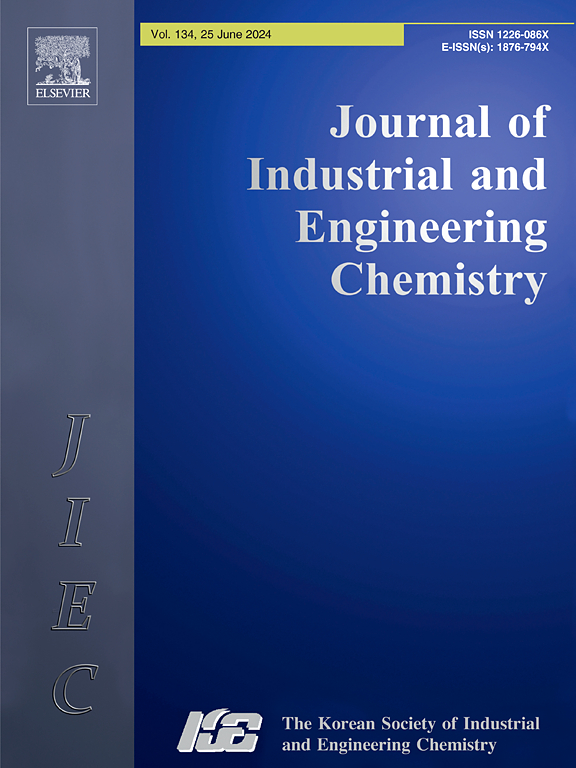高性能水氧化电催化材料的最新进展和最近的机器学习优势:截至2024年的概述
IF 5.9
3区 工程技术
Q1 CHEMISTRY, MULTIDISCIPLINARY
Journal of Industrial and Engineering Chemistry
Pub Date : 2024-12-05
DOI:10.1016/j.jiec.2024.11.050
引用次数: 0
摘要
本文综述了金属有机骨架(MOFs)和高熵材料(hem)在推进能量转换方面的突破性潜力。近年来,利用太阳能光能进行清洁能源转换成为克服能源危机的潜在战略。mof和hem是一种多功能纳米结构材料,在能量转换方面受到越来越多的关注。mof由金属离子(M)与有机连接剂结合而成,具有纳米级的几何结构、可调的孔洞大小、灵活的骨架、超高的表面积、大的表面体积比、丰富的活性位点、快速的电荷传输和结晶度,提高了水的氧化效率。HEMs具有多组分随机分布和无序结构,扩大了催化活性位点范围,形成稳定的单相固溶结构。独特的熵稳定效应通过防止hem团聚增加了活性位点,从而提高了稳定性。本文综述了MOFs基电催化材料和HEMs基电催化材料在析氧反应(OER)中的应用,以及材料的形态调控和结构调整如何提高活性和增加活性位点。最近,机器学习(ML)模型揭示了描述符影响过电位的作用,揭示了mof和HEMs催化活性的来源。这些ML模型降低了成本,并为设计高效催化剂提供了指导。本文探讨了基于mof和HEMs的电催化材料的发展路线图,通过ML模型的前沿来塑造燃料技术的未来。本文章由计算机程序翻译,如有差异,请以英文原文为准。

Recent progress of top-performing electrocatalytic materials for water oxidation and recent machine learning edge: An overview upto 2024
This comprehensive review explored the breakthrough potential of metal–organic framework (MOFs) and high entropy materials (HEMs) for advancing energy conversion. Solar light utilization for clean energy conversion become the potential strategy to overcome the energy crisis, in recent years. MOFs and HEMs are multifunctional nanostructured materials receiving accelerated attention in energy conversion. MOFs consist of metal ions (M) combined to organic linkers and have nanoscale geometry, tunable cage with porous size, flexible skeletons, ultrahigh surface area, large surface-to-volume ratio, abundant active sites, fast charge transportation and crystallinity which enhanced the water oxidation efficiency. HEMs have multi-component random distribution with disordered structure which extending the catalytic active-sites range and forming stable monophase solid-solution architecture. The unique entropy stabilization effect increased the active sites by preventing HEMs agglomeration which in turn improved the stability. In this review, we summarized MOFs and HEMs based electrocatalytic materials in oxygen evolution reaction (OER) and how morphology regulation and tuning the structure of material enhanced the activity and increased the active sites, respectively. Recently, machine learning (ML) models reveal the role of descriptors influencing the overpotential and exposed the origin of MOFs and HEMs catalytic activity. These ML models reduced the costs and served as a guide for designing efficient catalysts. This review delves a roadmap for the advancement of MOFs and HEMs based electrocatalytic materials, shaping the future of fuel technologies with the cutting edge of ML models.
求助全文
通过发布文献求助,成功后即可免费获取论文全文。
去求助
来源期刊
CiteScore
10.40
自引率
6.60%
发文量
639
审稿时长
29 days
期刊介绍:
Journal of Industrial and Engineering Chemistry is published monthly in English by the Korean Society of Industrial and Engineering Chemistry. JIEC brings together multidisciplinary interests in one journal and is to disseminate information on all aspects of research and development in industrial and engineering chemistry. Contributions in the form of research articles, short communications, notes and reviews are considered for publication. The editors welcome original contributions that have not been and are not to be published elsewhere. Instruction to authors and a manuscript submissions form are printed at the end of each issue. Bulk reprints of individual articles can be ordered. This publication is partially supported by Korea Research Foundation and the Korean Federation of Science and Technology Societies.

 求助内容:
求助内容: 应助结果提醒方式:
应助结果提醒方式:


